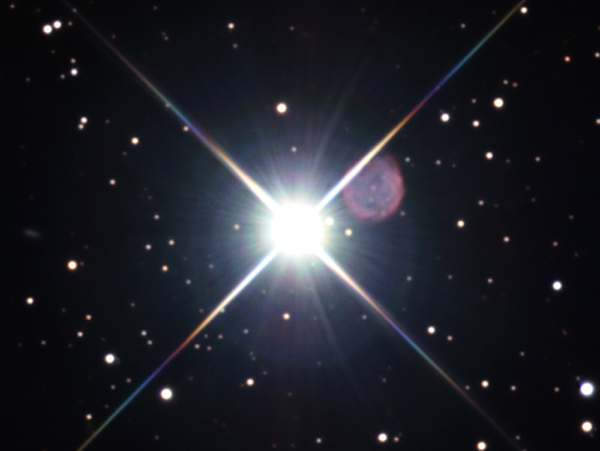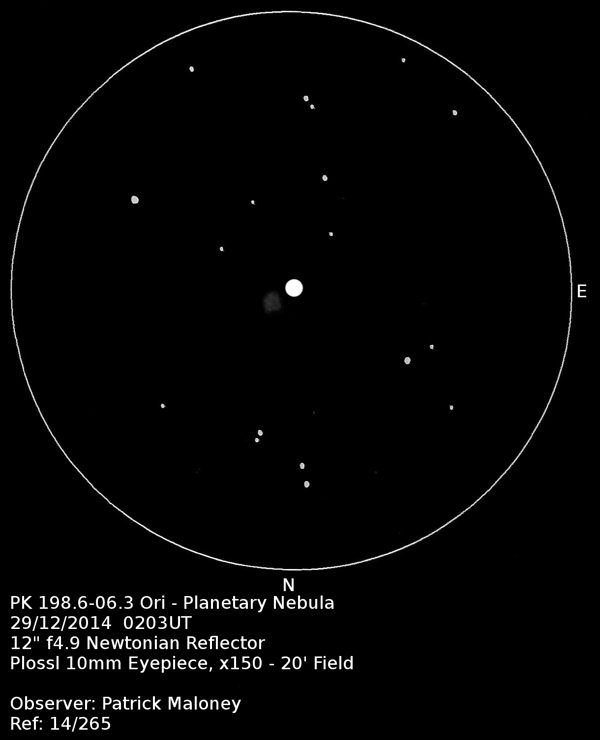NGC 1893 in Auriga and Abell 12 in Orion
December 2020 - Nebula and Cluster of the Month
After raised eyebrows from James last time, I’m restricting myself to a single nebula and a single cluster this month!
For our cluster, I’m turning to Auriga, a constellation richly endowed with open clusters, no fewer than three of which are in Messier’s catalogue. The triangle of stars delineated by the stars θ Aur, ι Aur and β Tau is the heart of this concentration of clusters. We’re going to look at a somewhat overlooked example, NGC 1893.

NGC 1893 lies about 50’ east of the little asterism formed by the 5th and 6th magnitude stars 16, 17, 18 and 19 Aur. This makes it an easy target.
It was discovered in 1827 by John Herschel, who gave it the number 351 in his catalogue of 1833. He describes it as a rich coarse cluster of scattered stars, 9 – 15 magnitude; more than fills field.
The cluster is embedded in the extensive nebula IC410, a star-forming region in which NGC 1893 itself formed. The cluster is fairly young, and observations in X-rays from the Chandra satellite suggest that it contains between 4000 and 5000 stars, though most of these are not detectable visually, of course.
The Deep Sky Field Guide to Uranometria gives the cluster an overall magnitude of 7.5 and credits it with 60 stars, the brightest of which is magnitude 9.3. It assigns it a diameter of 12’. Archinal & Hynes, on the other hand, state that there are 270 stars and that the diameter is 25’. They agree on the magnitude of the brightest star. My observations of this cluster suggest a diameter of around 20’.
The Trumpler classification is II3r n, which indicates a detached cluster with little central condensation (II), a wide range of magnitudes, both bright and faint stars (3), that it’s rich (r, more than 100 stars). and that it’s involved in nebulosity (n). My own visual description reads A large, bright cluster. Over 60 stars counted in a diameter of about 20', many in a long north-south chain. Some concentration, moderate variation in the stars' magnitudes and pretty well detached.
In a moderate telescope (say 12”/300mm), the cluster is seen to lie in a rich Milky Way field, with about 60 stars visible in a 30’ field. It’s unlikely that all of these are cluster members. The cluster itself takes on a ‘Y’ shape, with the downstroke heading almost due south, this being the most prominent feature of the cluster.
The nebula, IC 410, in which the cluster lies, is difficult but can be viewed on a good night with 12” or more of aperture, especially if a UHC or OIII filter is used. It appears as a slight mist around the stars. The most easily visible portion of the nebula is to the north-west of the cluster.
This month’s nebula presents a bit more of an observing challenge. The object in itself would be much easier to see if it were somewhere else. The planetary nebula PN G 198.6-06.3 (or Abell 12) lies a mere 50” from magnitude 4.1 μ Orionis. μ lies 2.8° north-east of Betelgeuse, and thus it is easy to get your field of view to the right place, but actually seeing the object is another matter.

Magnitudes given for this object vary considerably and I have seen estimates from 12.4 to 13.9. My thoughts are that it’s likely to be about magnitude 13, but it appears more difficult because of the presence of the bright star.
The problem is that on most nights, the nebula lies within the halo of the star. To see Abell 12 at its best, you will need a still night with low humidity. Having said that, it is visible on sub-optimal nights, but is much more difficult. On poorer nights, I find the nebula virtually swamped by the aura from μ Ori, and never visible without the OIII filter in place. I haven’t tried a UHC filter on this object.

The nebula fades in and out of visibility with micro-changes in the seeing, and when visible, presents a featureless circular patch of dim, grey light. Images of Abell 12 do show some structure, but it’s subtle and unlikely to be detected by a visual observer. If you know differently, please let me know.
I’ll finish 2020’s offerings by wishing you as merry and as enjoyable a Christmas / Midwinter / Yuletide as possible under the current strained circumstances. Here’s wishing for clear skies in a pandemic-free 2021.
| Object | RA | Dec | Type | Magnitude |
|---|---|---|---|---|
| NGC 1893 | 05h 22m 47s | +33° 26’ 21” | Open cluster | 7.5 |
| Abell 12 | 06h 02m 20s | +09° 39’ 15” | Planetary nebula | about 13 |